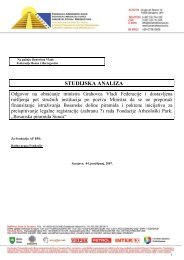The Complete Guide To Mysterious Beings - Galaksija
The Complete Guide To Mysterious Beings - Galaksija
The Complete Guide To Mysterious Beings - Galaksija
Create successful ePaper yourself
Turn your PDF publications into a flip-book with our unique Google optimized e-Paper software.
An old book titled History and Antiquities of Allerdale offers this undated description of a giant<br />
found in Cumberland, England, sometime in the Middle Ages. It is supposed to be ”A True Report<br />
of Hugh Hodson, of Thorneway.”<br />
<strong>The</strong> said giant was buried four yards deep in the ground, which is now a corn field. He was<br />
four yards and a half long, and was in complete armour: his sword and battle-axe lying by<br />
him. His sword was two spans broad, and more than two yards long. <strong>The</strong> head of his battleaxe<br />
a yard long, and the shaft of it all of iron, as thick as a man's thigh, and more than two<br />
yards long.<br />
His teeth were six inches long, and two inches broad; his forehead was more than two spans<br />
and a half broad. His chin bone could contain three pecks of oatmeale. His armour, sword,<br />
and battle-axe are at Mr. Sand's of Redington, and at Mr. Wyber's, at St. Bees.<br />
A man fifteen feet tall, dressed in armor – a true Goliath! We have no way of knowing what<br />
happened to this interesting find. <strong>The</strong> bones and armor may have been scattered eventually among<br />
dozens of souvenir collectors.<br />
In those early times the discovery of bones and fossils of prehistoric animals were often misjudged<br />
to be the bones of giants. And there were Hugh Troys in those days who were quite willing to turn<br />
mastodons into ancient giants. One such prankster appears to have been a physician named Dr.<br />
Mazurier who wrote a remarkable pamphlet in 1613, claiming that the tomb of a giant had been<br />
unearthed near the castle of Chaumont. <strong>The</strong> tomb contained a human skeleton over twenty-five feet<br />
long, with shoulders ten feet wide.<br />
A controversy soon raged over this discovery and other pseudoscientific pamphleteers accused Dr.<br />
Mazurier of buying some big bones from some workmen and hoking up his giant. <strong>The</strong> bones still<br />
exist in the Musée de Paléntologie in Paris as a part of their mastodon collection.<br />
<strong>The</strong> best-known hoax of this type took place in Sussex, England, in 1908, when an amateur<br />
archaeologist named Charles Dawson purportedly found fragments of bone near Piltdown. <strong>The</strong><br />
fragments seemed to be part of a ”dawn man” dating back hundreds of thousands of years.<br />
Peleontologists at the British Museum of Natural History became quite excited over this ”Piltdown<br />
Man” and it became one of science's most important artifacts. Dawson died in 1916, honored and<br />
distinguished as the discoverer of a vital link to man's distant past.<br />
Thirty-six years passed before a new generation of scientists took a second look at the ”Piltdown<br />
Man's” illustrous skull. <strong>The</strong>y subjected it to carbon fourteen radioactivity tests, and sprinkled it with<br />
the magical chemicals that had been developed since Dawson's time. <strong>The</strong>ir conclusions rocked the<br />
scientific world. <strong>The</strong> jaw of the ”dawn man” belonged to an ape who had joined his ancestors<br />
around 1900. Even worse, there was evidence that some highly skilled dentist had carefully and<br />
lovingly filed away at the teeth and remodeled part of the bone structure. <strong>The</strong> ”Piltdown Man” was<br />
a cunning fake!<br />
Had Charles Dawson pulled the leg of science? Or was he, himself, the victim of a prank? If so,<br />
who could have had the knowledge, skill, and motivations to execute such an elaborate hoax? <strong>The</strong><br />
discovery of the manipulation created a whole new mystery and raised questions which will<br />
probably never be answered.<br />
As soon as Europeans began to explore the distant reaches of South America, they encountered a<br />
breed of giant men. <strong>The</strong> southernmost parts of Argentina and Chile were labeled Patagonia by<br />
Magellan because the giants there wore leather moccasins and ”pata” is Spanish for ”hoof.” In June<br />
1520 when Magellan's fleet anchored at Port San Julian on the Argentine coast, a giant appeared on<br />
the beach. Pigafetta, a member of Magellan's staff, later wrote: ”This man was so tall that our heads<br />
scarcely came up to his waist, and his voice was like that of a bull.”<br />
Magellan's men managed to capture two of the giants, intending to take them back to Europe, but<br />
they died in chains en route.<br />
Next, the British explorer Drake docked in Port San Julian in 1578 and had a skirmish with ”men of<br />
large stature” who towered at seven feet six inches tall. He lost two of his men in the battle.










